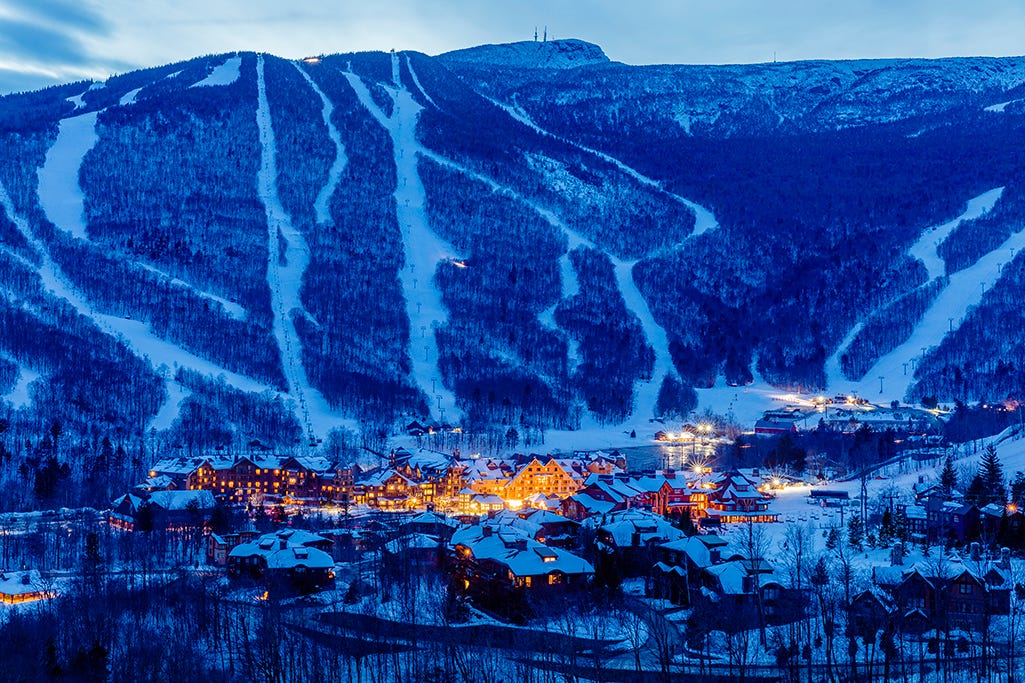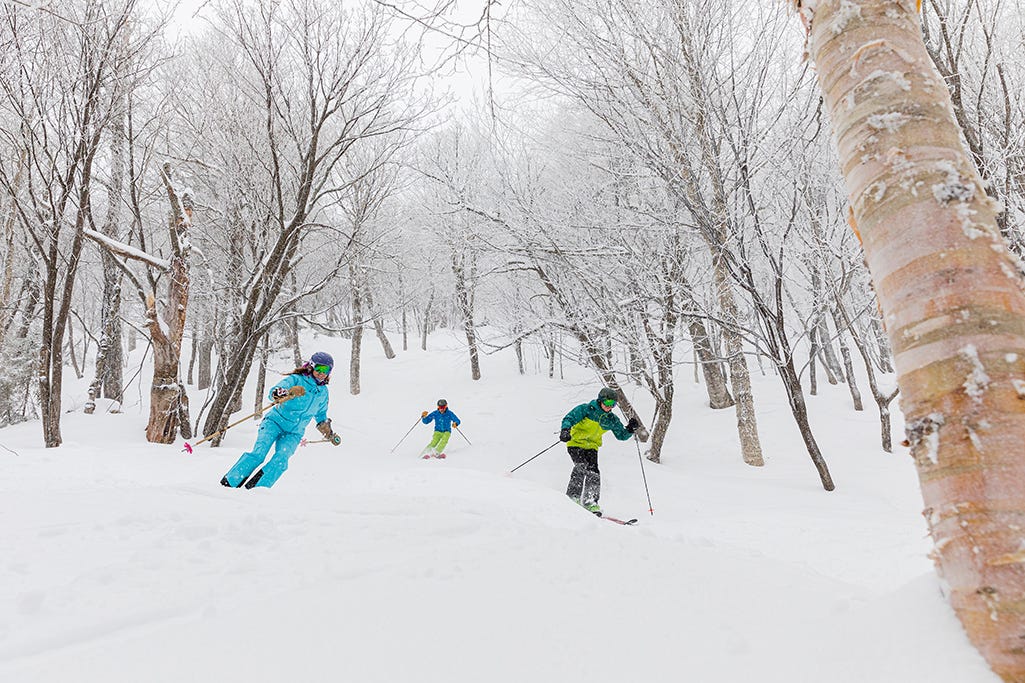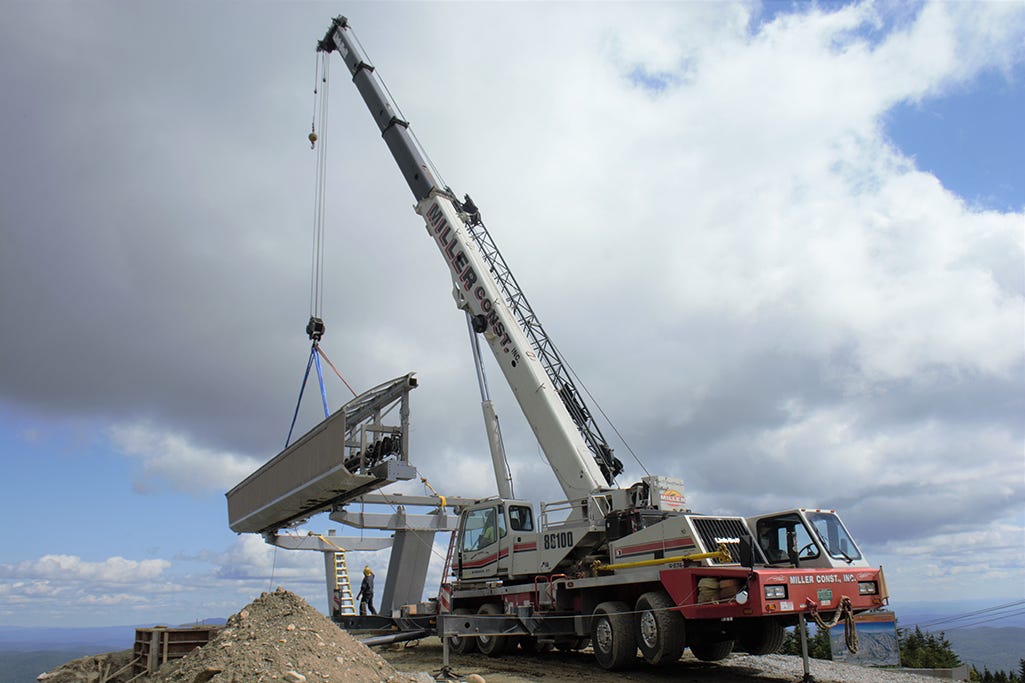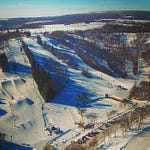The Storm Skiing Podcast is sponsored by Mountain Gazette - Listen to the podcast for discount codes on subscriptions and merch.
Who
Tim Baker, Vice President and Chief Operating Officer of Vail Resorts’ Eastern Region. His territory includes Wildcat, Attitash, Mount Sunapee, and Crotched in New Hampshire; Stowe, Okemo, and Mount Snow in Vermont; Hunter Mountain in New York; Jack Frost, Big Boulder, Liberty, Roundtop, and Whitetail in Pennsylvania; Mad River, Alpine Valley, Boston Mills, and Brandywine in Ohio; Mount Brighton in Michigan; Paoli Peaks in Indiana; Wilmot in Wisconsin; Afton Alps in Minnesota; and Hidden Valley and Snow Creek in Missouri.
Recorded on
November 1, 2021
Why I interviewed him
Because Vail, suddenly and indisputably, is the new king of Northeast skiing. In three surprise acquisitions between February 2017 and July 2019, the Colorado-based company vacuumed up four ski areas in New Hampshire, three in Vermont, one in New York, and five in Pennsylvania. It changed everything. Immediately. A ski region puttering along on the decades-old model of $1,500 single-mountain season passes found itself in a cage match with the feisty Epic Pass – Vail instantly dropped Stowe’s season pass price from just over $2,300 to around $800. The ink wasn’t dry on the contract before Sugarbush dropped its pass price by 30 percent. At least seven other Vermont ski areas followed, to varying degrees. Former Sugarbush owner Win Smith cited Vail’s purchase of the 17-mountain Peak Resorts portfolio, just over two years later, as one of his primary motivations for selling the mountain to Alterra. Empire established, Vail popped open the nuclear suitcase with a pair of Northeast-specific Epic Passes that undercut even most family-owned single-lifters. For skiers, the direct and indirect impacts of this takeover are widespread and mostly positive. Northeast season passes haven’t been this affordable in decades. Almost any resort of size or note that didn’t get swept up by Vail joined the Ikon or Indy passes, meaning skiers can now access 26 of New England’s best ski areas on just three passes. A savvy early-season shopper who grabbed a $359 Northeast Epic Midweek pass, a $729 Ikon Base Pass, and a $279 Indy Pass can resort-hop the Northeast all season – and tack on a Western trip or two – for just $1,367. In 2016, a season pass to Stratton – just Stratton – was $1,199. Okemo, which likely included some level of Mount Sunapee access – was $1,619. Imagine? A month’s mortgage payment for nothing more than 8,000 miles of Okemo groomers. No more. Frequent skiers who think ahead have never had more options across a broader spectrum of the ski landscape. They have Vail to thank for that, whether they like it or not.

What we talked about
Life in the National Football League; growing up as a skier in West Texas; Vail Resorts in its real estate development days; the value of candid feedback; the special challenges of working at Beaver Creek and Crested Butte; how do deal with the great migration to the mountains over the long term; Vail’s institutional enthusiasm for its Eastern expansion; the “intense love” of Midwestern and Northeastern skiers and riders; how the different sorts of resorts in Vail’s vast portfolio works together; whether Vail is open to more acquisitions in the Northeast or Midwest; if they’re bidding for Jay Peak; what Vail looks for in a new mountain; whether the Epic Pass could add partners – à la Telluride or Sun Valley in the West – in the East; integrating Vail’s Eastern resorts within the company’s culture; adapting to Eastern weather; why Vail offers Northeast-specific Epic Passes; a brief history of the Epic Pass from someone who saw it emerge first-hand; broadening the season pass beyond the interests of a small group of locals; how the Epic Pass and its early deadlines helped stabilize a traditionally fickle industry; why Vail isn’t concerned about crowding even after the 20 percent price drop and booming Epic Pass sales; why Vail is still selling expensive day tickets even as its Epic Day Pass product offers the same access for a fraction of the cost; why Vail discarded the reservation system that it developed for the 2020-21 ski season; the transformative lift upgrade in progress at Okemo; why Vail isn’t worried about overcrowding with a half-dozen high-speed lifts now at the ski area; the new six-packs coming to Mount Snow and Stowe; the status of the Mount Sunapee expansion; why Vail prioritized upgrading the beginner double-double and whether they’re considering an upgrade to the summit triple; details on the Wildcat Express upgrade; whether Wildcat will return to its former commitment to the long season; why Vail is replacing the double-triple at Jack Frost with a quad and how that will increase uphill capacity; determining what to replace on a small hill with a dozen or more antique lifts; and Afton Alps’ mammoth, antique lift fleet and why Vail has no intentions to upgrade it anytime soon.

Why I thought that now was a good time for this interview
Because if we thought Vail went nuclear with Northeast-specific Epic Passes, it went – what’s after nuclear? Super nuclear? It went super nuclear with 20 percent Epic Pass price drops last spring. While Vail’s competitors, flush from a Covid-charged burst in season pass sales, did not respond with price drops of their own (yet), the surprise move did hit big. First, Epic Pass sales exploded 67 percent compared to last year. It’s impossible to say, at this point, whether those sales came at the expense of other ski area operators’ pass sales, or if, as Vail claims, a large chunk of those are skiers who used to buy lift tickets switching to Epic Day Passes. Either way, Vail’s huge price drops, combined with its decision last spring to ditch its pandemic-era reservation system, have catalyzed concerns about overcrowding once the lifts start spinning.
At the same time, Vail is launching the first phases of a gut renovation of its Northeast properties, starting with a monster lift project that will drop new six-packs on Stowe and Mount Snow and materially change the ski-day experience at many of its mountains across the region. Okemo will have a massive lift overhaul in place for this season. Nearly five years after kicking the Northeast door down with the Stowe purchase, Vail is settling into the the region and sending the very clear message that the East is a huge and growing priority for the company. I wanted to get Tim’s insight into how Vail planned to manage crowds, why the company focused investment where it did, and what may be next for the ever-growing king of lift-served skiing.
Questions I wish I’d asked
I had planned to ask about longer-term plans for upgrading Wildcat’s fleet of aging triples, any plans for Hunter mountain, why Vail isn’t taking a Mount Brighton-style demolition derby approach to its antique Ohio and Pennsylvania mountains, Vail’s vaccine mandate, Powdr’s Fast Tracks program, and a few other items, but we squeezed as much as we could into an hour. Considering the size of Tim’s realm, I think we covered quite a bit of the most important things.
Why you should ski Vail East
Let me start with this: having the largest collection of ski areas in the East is not the same as having the best collection of ski areas in the East. The Ikon Pass’ seven New England ski areas – Sugarbush, Killington, Pico, Stratton, Loon, Sugarloaf, and Sunday River – are a far more interesting set of mountains than Vail’s: Stowe, Okemo, Mount Snow, Wildcat, Attitash, Mount Sunapee, and Crotched. The reason is simple: these particular Ikon mountains, in general, do a far better job of curating a balanced skier experience than the New England Epic mountains (they also tend to stay open later, with Sugarbush, Sugarloaf, and Sunday River aiming for May closings, and Killington typically shooting for June). Stowe is, without question, outstanding, as good a mountain as you’ll find in the Northeast, nearly without peer. Okemo and Mount Snow, however, are deeply flawed operations – they likely have the highest grooming-to-total-terrain ratio of any large mountains in North America. This serves their demographic of big-city-intermediates-who-think-they’re-experts well. The rest of us are left begging for more terrain variety, a bit less grooming, a lot more glading. Again, Vail inherited these mountains, and my expectation is that the company will eventually nudge them into a 21st century terrain philosophy (which all of their Western mountains follow). For now, the expert Epic skier really has little compelling terrain beyond Stowe and Wildcat, with a little Attitash and Sunapee when conditions are good. If Vail has an opportunity to buy Jay Peak, Smugglers’ Notch, or, eventually, Saddleback, they should do it, as adding any of these would help immensely in correcting this imbalance.

All that said, most skiers are not experts and do not care about my preoccupation with a balanced mountain. For those folks, for families, for explorers, for the midweek cruisers or the early-morning corduroy-chasers, Vail’s sprawling empire is almost too good to be believed. The Midwest and Pennsylvania mountains give desk-chained cityfolk a way to make midweek turns. Hunter is one of the largest ski areas in New York State and just over two hours from Manhattan. Mount Snow has probably the best terrain park in the East, and one of the best in the entire country. Okemo – the second-busiest ski area in the Northeast, behind only Killington – is absolutely huge (all the more reason they can probably let a bit of it stay wild). Crotched has one of the wildest night-skiing scenes in the region.
All of which, when combined with the Western access included on an Epic or Epic Local Pass, makes it almost impossible not to buy some version of this pass if you live anywhere from Philadelphia north.
Additional Resources
Vail buys Stowe (Feb. 22, 2017)
Vail buys Triple Peaks (June 4, 2018)
Vail buys Peak Resorts (July 22, 2019)
Vail buys Wilmot (Jan. 19, 2016)
Vail buys Mount Brighton (Dec. 12, 2012)
Lift Blog’s lift inventory for:
Vermont
New Hampshire
New York
Pennsylvania
Ohio
Indiana
Michigan
Wisconsin
Minnesota
Missouri
Snow Creek is one of the very few U.S. ski areas the site has not inventoried yet
















Podcast #60: Vail Resorts Eastern Region VP & COO Tim Baker